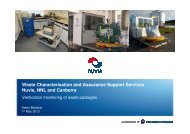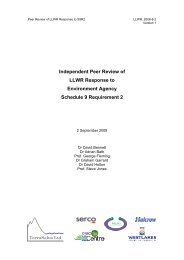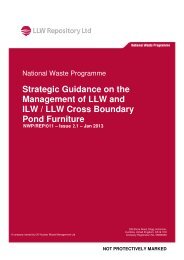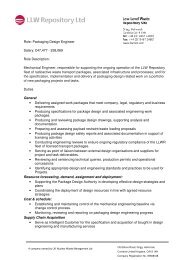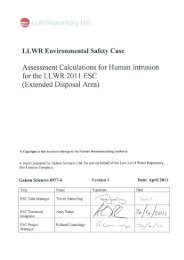Halcrow, Coastal Studies Forward Programme Data Compilation ...
Halcrow, Coastal Studies Forward Programme Data Compilation ...
Halcrow, Coastal Studies Forward Programme Data Compilation ...
You also want an ePaper? Increase the reach of your titles
YUMPU automatically turns print PDFs into web optimized ePapers that Google loves.
The approach presented provides a methodology and predictions for the futuregeomorphological development of the Irt, Mite and Esk estuaries, over the next5,000 years. The changes in geomorphology are predicted to arise as a result ofthree factors:The predicted rise in sea-levels described in UKCIP02 and BIOCLIM(summarised in Thorne 2007)The projected increase in sediment supply from the erosion of adjacentcoastal cliffsChanges in the accommodation space for channel evolutionThe results suggest that over the next 80 years, the projected changes to theestuaries are minimal. Between 25 and 80 years the projected rise in relative sealevelwill tend to widen the estuarine channels as tidal prisms increase. During thisperiod, however, sediment supply to the estuaries from open coast cliff erosionwill allow the estuaries to keep pace with sea-level rise so reducing the rate ofincrease in both tidal prism and channel width. The result in 80 years from now isprojected to be little change from existing conditions.The rise in relative sea-levels over the period 80 to 5,000 years after present isprojected to increase the channel dimensions of the three estuaries by a significantamount. The Irt channel will experience maximum change due to itsaccommodation space: it flows through a wide valley allowing its channel toexpand as sea-levels rise. In the Esk, the constraints provided by the rock valleysides provide minimal accommodation space that will not allow channel expansionin the more seaward sections of the estuary. Therefore, a broad inner channel willbe connected via a narrow, high velocity, outer channel to the open coast. It isprojected that tidal ponding will occur in the upper Esk.The pathway taken by the Irt to the sea is predicted to remain approximately as itis today. This is due to the projected increase in gravel supply to the Drigg barrierbeach 2 which will prevent any major avulsion of the Irt to a more westerly outlet tothe sea.2 Note that the structure of the Drigg barrier beach / spit is currently under investigation using data from ageophysical survey and borehole investigation. Preliminary geophysical data suggests the barrier beach / spit is aridge of glacial sediment with limited cover of Holocene sediments.Doc No 1 Rev 2: Date: May 2010 40







